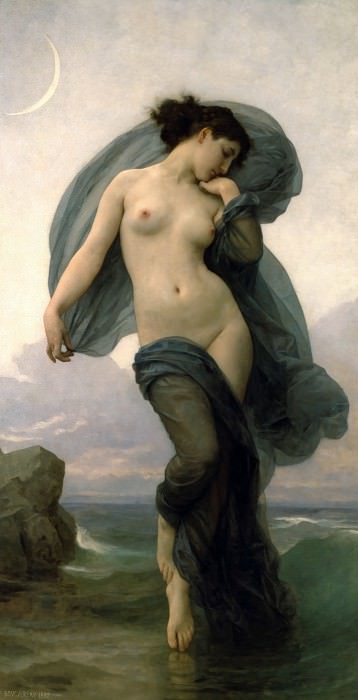Evening Mood Adolphe William Bouguereau (1825-1905)
Adolphe William Bouguereau – Evening Mood
Edit attribution
Download full size: 2533×4955 px (2,2 Mb)
Painter: Adolphe William Bouguereau
Location: National Museum of Art, Havanna (Museo Nacional de Bellas Artes).
1879; canvas, oil; 300×218; Musée d’Orsay. William Bouguereau chose as the subject for his painting the famous myth of the emergence of Venus, the goddess of love and beauty, who, according to legend, arose from the foam of the sea off the coast of Cyprus. The composition of the scene is quite similar to the famous masterpiece by Sandro Botticelli, the Renaissance genius, but in both paintings one can clearly see the hand of the author and one can see the traces of the time in which the work was done. The painting by Bouguereau is light, airy, executed in light colors, almost glowing with delicate colors.
Description of William Bouguereau’s The Birth of Venus
1879; canvas, oil; 300×218; Musée d’Orsay.
William Bouguereau chose as the subject for his painting the famous myth of the emergence of Venus, the goddess of love and beauty, who, according to legend, arose from the foam of the sea off the coast of Cyprus. The composition of the scene is quite similar to the famous masterpiece by Sandro Botticelli, the Renaissance genius, but in both paintings one can clearly see the hand of the author and one can see the traces of the time in which the work was done.
The painting by Bouguereau is light, airy, executed in light colors, almost glowing with delicate colors. Despite the many sensual explicit images it leaves an impression of unsophisticated naturalness and antique simplicity.
The center of the composition is rightly Venus herself, standing on a huge seashell on the shore. Her pose is graceful, a little coquettish, filled with dignity. She is well aware of the power of her charms, but here she looks just a woman, barely awakened from her sleep. She is absorbed in herself and pays no attention to those who greet her. From under her eyelashes, the goddess stares out at the spectator.
Her arrival is proclaimed by the knights of the sea trumpeting into their shells. Dark-haired and dark-skinned, these three figures stand out sharply from all other characters in the picture. They surround their goddess, not daring to approach her, but they hold equally beautiful white-skinned women in their hands. The poses of all the participants unequivocally hint at carnal union.
The exception is the two children in the foreground. At Venus’ feet they play with a dolphin behind their backs they have tiny wings. They are angels who have broken away from the host of their brethren circling in the heavens above the head of the pagan deity. Or, perhaps, a flock of cupids, for the angels clutch a bow, a quiver, and arrows capable of kindling the flame of passion in a man’s heart.
Кому понравилось
Пожалуйста, подождите
На эту операцию может потребоваться несколько секунд.
Информация появится в новом окне,
если открытие новых окон не запрещено в настройках вашего браузера.
You need to login
Для работы с коллекциями – пожалуйста, войдите в аккаунт (open in new window).




















COMMENTS: 5 Ответы
Шедевр
У Бугро все шедевры!
Здравствуйте, подскажите пожалуйста, для чего картине добавлена вотермарка, это такая претензия на авторство – "Бурго, подвинься! ", или просто желание влезть между произведением и лицезреющим его?!
Чтобы было видно, откуда взят файл. Кроме того, это просьба составителя альбома.
Файл на странице с информацией – без вотермарка, если мешает, можно созерцать его 🤓
Руки прочь от Адольфа! 😡
You cannot comment Why?
The setting is a coastal scene at twilight. To the left, a rocky outcrop juts into the water. The sea is depicted with gentle waves and reflections, suggesting calm rather than a storm. The sky is a pale, cloudy expanse, with a crescent moon visible in the upper left corner, reinforcing the evening theme. The overall atmosphere is serene and dreamlike, with soft lighting that highlights the womans pale skin and the textured fabric.
The subtexts of Evening Mood appear to revolve around themes of beauty, transience, and perhaps a hint of sadness or longing. The title itself, Evening Mood, suggests a time of day associated with reflection and fading light, mirroring the introspective pose of the figure. The flowing fabric and gentle water can symbolize the passage of time or emotions. The womans nudity, combined with her gentle, almost vulnerable posture, could represent innocence, or perhaps a surrender to the elements and the passing of time. The presence of the crescent moon, a symbol often associated with femininity and cycles, adds another layer of symbolic meaning, hinting at renewal and mystery. The overall impression is one of quiet contemplation and ethereal beauty, a moment captured at the edge of day and night, reality and dream.